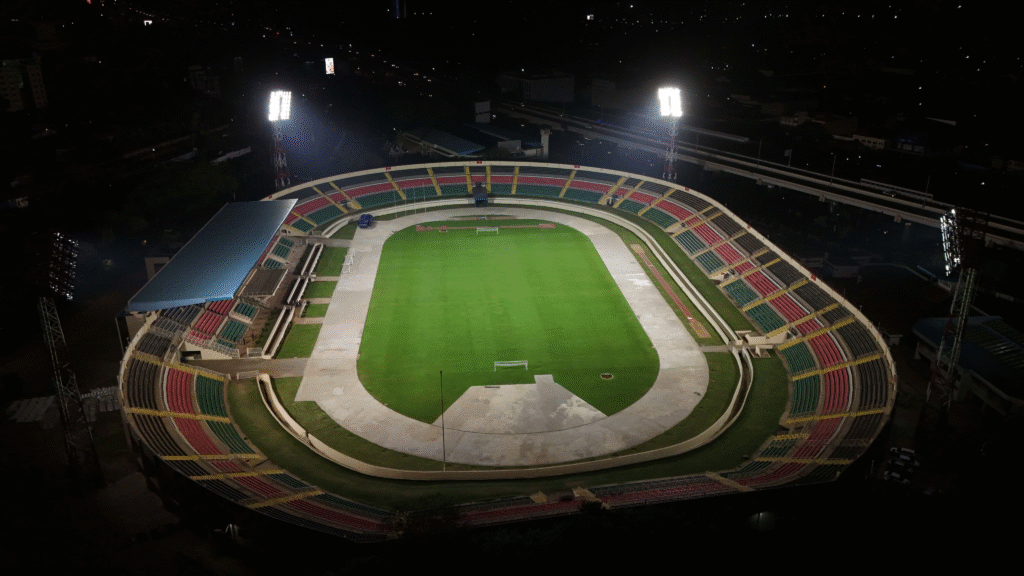During President Uhuru Kenyatta’s administration, the government faced backlash for deploying military officers to roles typically handled by civilians. Critics questioned the move, arguing it blurred the line between civilian rule and military involvement in governance. However, over time, results from the Kenya Defence Forces (KDF) began to change public perception.
Whenever major projects stalled or missed deadlines, the military was brought in—often under immense pressure—to rescue and complete them. What followed were transformations that spoke louder than the initial concerns.
Here’s a look at some of the major national projects that KDF stepped in to salvage and complete, often under tight timelines and public scrutiny:
Kasarani Stadium
By late 2024, Kasarani Stadium was under heavy criticism. Slated to host matches during the 2024 African Nations Championship (CHAN), the venue was incomplete and did not meet the standards set by the Confederation of African Football (CAF).

The government handed the project to the Ministry of Defence, which deployed military engineers to accelerate renovations. Within months, KDF installed modern lighting, drainage systems, VIP zones, and broadcast facilities.
By July 2025, President William Ruto visited the stadium and declared it ready for international events.
Nyayo Stadium
Long neglected, Nyayo Stadium had become unfit for international fixtures. With Kenya co-hosting CHAN 2024, the facility needed a quick turnaround.
Once again, KDF was deployed to restore the stadium. Upgrades included refurbished dressing rooms, better drainage, new seating, and enhanced floodlights. Media facilities were also modernised.
By March 2025, Harambee Stars hosted Gabon before a packed stadium. In July, Defence CS Soipan Tuya officially handed it over to Sports CS Salim Mvurya.

Kenya Meat Commission (KMC)
The Kenya Meat Commission had collapsed under poor management, debt, and outdated infrastructure. In 2020, KMC was transferred from the Ministry of Agriculture to the Ministry of Defence.
KDF quickly reorganised operations at the Athi River plant. Payments to farmers were streamlined, equipment was upgraded, and slaughter capacity significantly improved. Exports resumed, and confidence in the institution rebounded.
Defence officials credited the turnaround to military discipline and efficiency.
Nakuru–Kisumu Railway
Once a key transport line, the Nakuru–Kisumu railway had been dormant for 16 years. Vandalised and overgrown, it symbolised years of government neglect.
In 2020, KDF partnered with Kenya Railways and the National Youth Service to rehabilitate the metre-gauge railway. In just eight months and with KSh 3 billion, they restored 217 km of track, fixed bridges, revived 18 stations, and cleared overgrowth.
The line reopened in 2021, boosting trade and passenger movement in western Kenya. The military’s involvement was credited with saving costs and accelerating delivery.
Kenyatta International Convention Centre (KICC)
In preparation for the 2023 Africa Climate Summit, KICC underwent a major facelift under the watch of KDF.
Renovations included modern conference halls, improved audio-visual systems, air conditioning, and enhanced landscaping. Security systems and digital infrastructure were also upgraded.
Despite concerns about architectural changes, the venue was completed just days before the summit and went on to host over 20 African heads of state.
Nairobi Metropolitan Services (NMS)
In 2020, President Uhuru Kenyatta appointed General Mohamed Badi as Director-General of Nairobi Metropolitan Services (NMS) to address dysfunction in the capital’s administration.
Over two years, NMS transformed Nairobi—building over 350 km of roads, drilling 100+ boreholes, upgrading health centres, greening public spaces, and cleaning up streets.
Despite facing political resistance, NMS gained praise from many residents for restoring order and improving services. It formally handed back functions to the county government in 2022.
From stadiums to slaughterhouses, railways to city streets, the Kenya Defence Forces proved instrumental in rescuing critical projects that had stalled under civilian agencies. While the debate over military involvement in civilian matters continues, few can deny the lasting impact of these interventions.







